Sitting in the corner of the Acadia Room in the KC Irving Environmental Science Centre, I looked up. As the dying rays of light cut through the room something shimmered on the wall opposite. My interest piqued, I stood up and wandered over. Attached to the wall was a large framed poster, titled “Campus Master Plan”. It was a re-imagining of Acadia from a birds-eye view. New buildings, hundreds of trees, and a reorientation towards pedestrians were the hallmarks of this campus.
Intrigued, I took the time to do my research. With little to nothing available online, beyond a quick reference to the Senate Strategic Research Plan adopted in 2006, I did some digging. It took nearly three months before I was able to rest my hands on a physical copy of the Campus Master Plan.
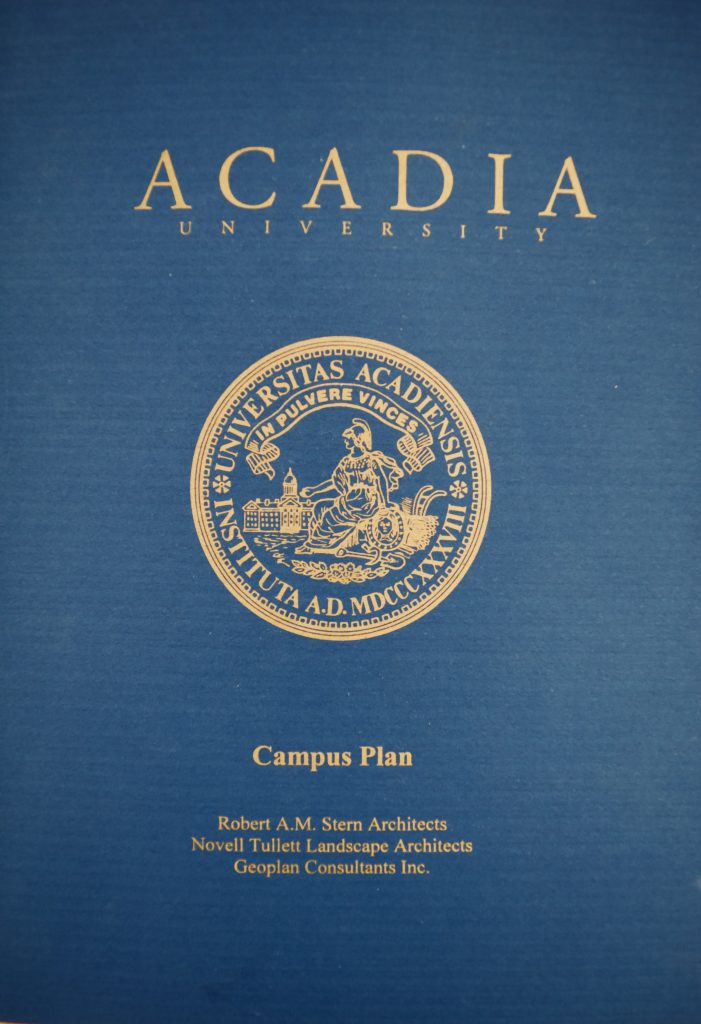
Described as a “topographical blueprint for the twenty first century”, the plan was meant to celebrate Acadia’s traditional architecture and strengthen its connection with the Town of Wolfville. This plan would focus on re-orienting the campus to pedestrians and incorporating natural features into its design, including a greenbelt to the south, dykelands and tidal meadows to the north, and the Bay of Fundy.
The plan came about as a result of the development of the KC Irving Environmental Science Centre, raising the standard for development on campus. This served as an inspiration for the Board of Governors who, in 1999 under the leadership of then-President Kelvin Oglivie, pursued the development of a campus plan. The final plan was adopted in 2002 by the Board of Governors with any major changes to require at least 2/3 of the Board’s approval.
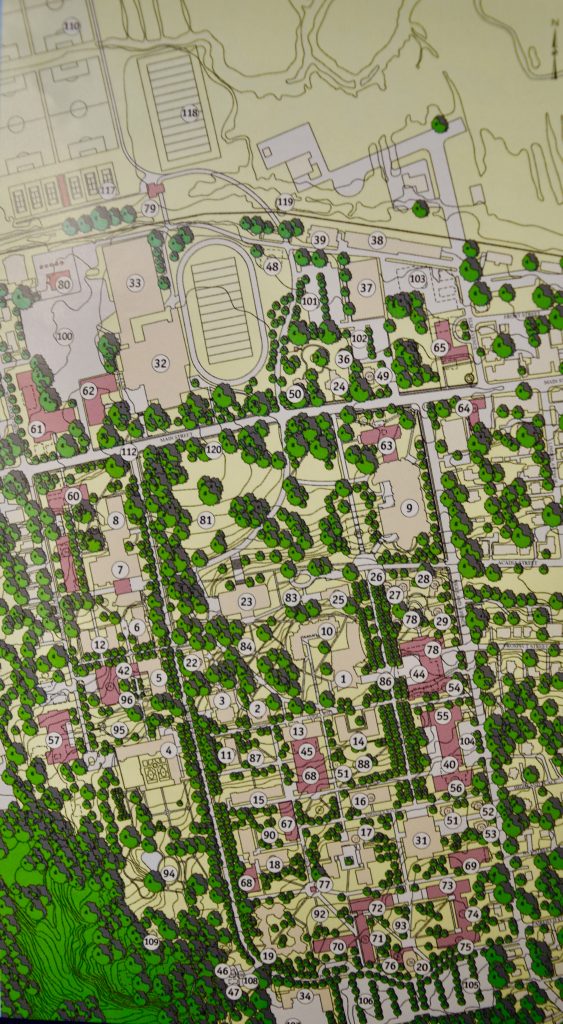
Robert A.M. Stern Architects, Novell Tullett Landscape Architects, and Geoplan Consultants Inc. came together to build this plan. Robert A.M. Stern Architects (RAMSA) is very well known for various Ivy League construction projects, including two of Yale University’s newest residential colleges, the Spangler Campus Centre at Harvard University, the Moore Psychology Building at Dartmouth College, and the Fitness and Aquatic Centre at Brown University.
The Campus Master Plan (CMP) called for the purchase of 8 hectares of property. This would include buying University Ave from the Town of Wolfville, Catherine Court, the block where Troy currently resides, various residential lots on Westwood Ave, the funeral home next to the Athletics Complex, and apartments on the south side of Main St. where ‘Brown House’ is located.
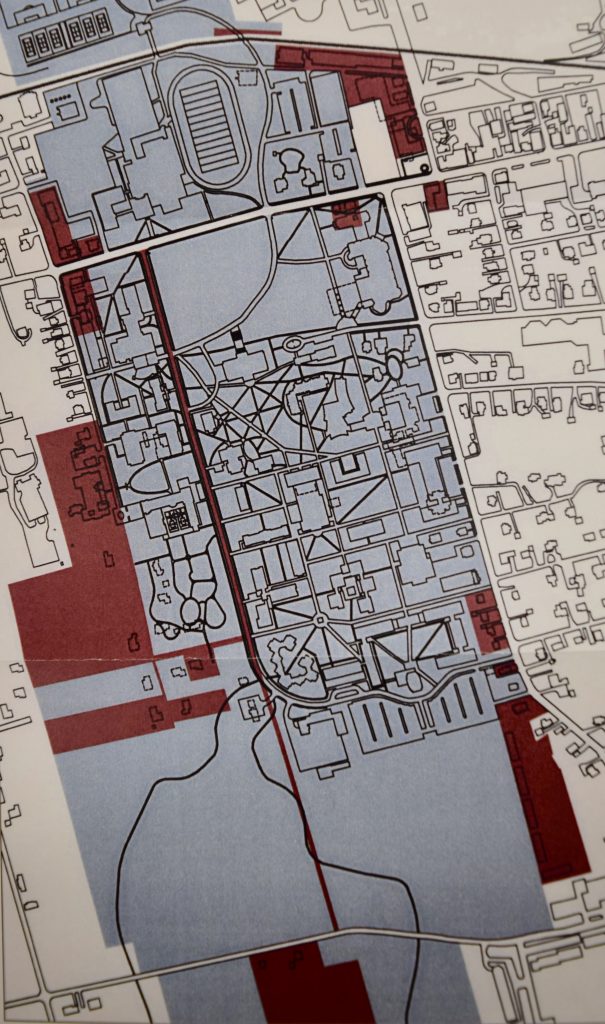
Red denotes property the university has to buy
This would be coupled with the construction of approximately 87,900 square metres of new buildings organized around pedestrian paths and quadrangles. Some of the major changes to campus would include:
- New buildings on the western edges of campus to form a Science Quadrangle
- Relandscaping the front of campus on the ‘College Lawn’
- Buying University Ave to demolish the portion south of campus
- Demolishing the existing library and rebuilding it incorporated into Fountain Commons in the centre of campus
- Building of 9 new residences
- New school of business where the funeral home resides
- Goal is 75% students on campus
- Building of 2-3 new dining halls contained within or adjacent to residence halls located on southern half of campus
- The creation of a pedestrian campus by making University Ave smaller and thinner
- All students receiving an unlimited transit pass
- Acadia University supporting Main Street retail and densification
- Discouraging building north of the railroad tracks
- Advocating for the restoration of high speed rail to Halifax

The CMP broke up the proposed changes into 10 separate areas. A) The East Gateway, B) College Lawn, C) West Gateway, D) Historic Core, E) Dykeland Playing Fields, F) Middle Zone, G) South Zone, H) Sciences Quadrant, I)Humanities Quadrant, and J) Botanical Garden & Greenbelt.
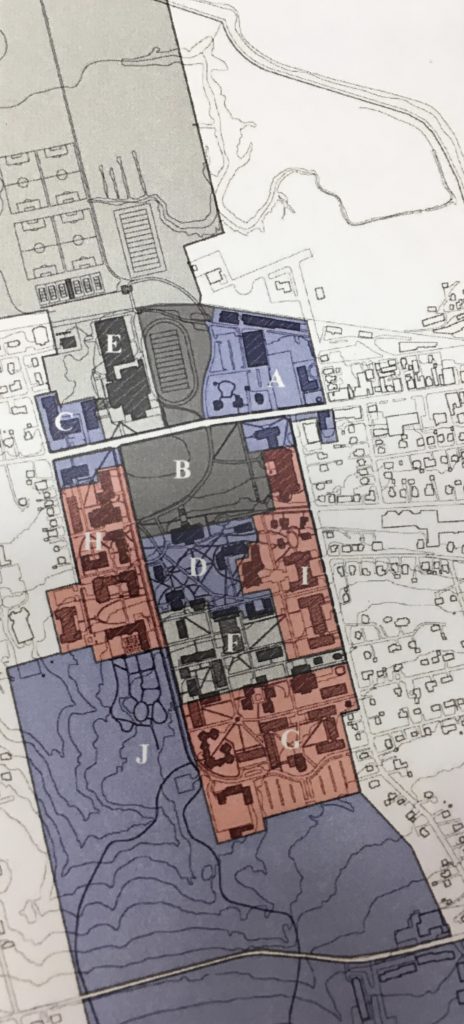
East Gateway
The CMP identified parking around campus as wholly inadequate. The views one is first introduced to driving to Acadia detract what the university is actually like, leaving a poor first impression of Acadia. Coupled with the grotesque imposition of the BAC it presented an unique architectural challenge.
To combat these the CMP proposed the following solutions. A new three-story building would be constructed in the parking lot behind the Wolfville Baptist Church. This would add a university store and impress visitors upon arrival. All of the land north of Main St. and Elm Ave. would be bought to create a Conference Centre Inn that would host major academic meetings and work with local B&Bs.
A new parking lot with direct access to Main St. would be constructed beside the existing Raymond Field, screened by trees. The Wong Centre would be moved to Main St. and a new three-story building at the corner of Main and Highland Ave would be erected that would be connected to the existing BAC. This would house an art gallery, university history museum, classrooms, and offices. The CMP identified the importance of making the building architecturally inviting, as it would screen the BAC from the main view.
College Lawn
The CMP identified the poorly landscaped College Lawn as a major flaw at Acadia. This is the area directly in front of University Hall. The poor landscaping and seemingly random locations for crosswalks proved problematic, and poor lighting did a disservice to the pride of Acadia’s ‘front doorstep.
To combat these challenges, the CMP proposed to plant historically appropriate species of trees around the College Lawn. Space created by the elimination of the Vaughan Memorial Library would create considerable space to add to the lawn, which would preserve and enhance the view of the dykes. A wooden split rail fence along the north and south sides of Main St. would be erected to discourage jaywalking. This is similar to fences that exist at Yale University.
The central heating plant of the university and its smoke stacks would be demolished. These have been characterized as brutalist and out of place, made famous by an Alex Colville painting “Professor of Romance Languages”. The lawn itself would be extended across the street to Raymond Field, replacing what is now concrete.
West Gateway
The CMP identified the houses at the corner of Westwood Ave and Main St as unnecessary and detracting from the character of the university. Coupled with the unlandscaped portion of grass by the Elliot Chemistry Building, the CMP also noted how University Ave was too heavily trafficked. This posed serious risks for pedestrian and vehicular accidents in addition to traffic bottlenecks. The presence of a funeral home on the front doorstep of the university was identified as a flaw, as it gives visitors the wrong impression. The parking lot at the Acadia Athletics Complex (AC) was considered as far too exposed, considered aesthetically displeasing.
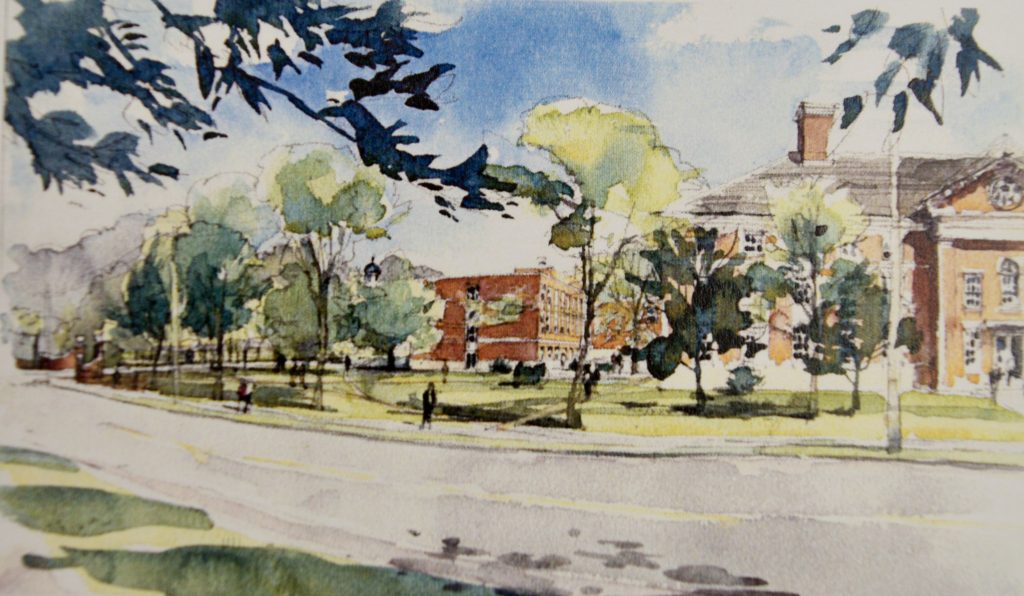
The CMP proposed several solutions for the West Gateway. These included purchasing and demolishing the apartments that exist at the corner of Westwood Ave and Main St to create a new science building. Construction of a new building would mean the creation of a science quadrangle, which fits with the CMP’s main goal of creating a pedestrian friendly campus.
Alumni Gates would be erected at the entrance to University Ave, with the avenue itself slimmed down to approximately 24 feet across. The funeral home on Main St. would be demolished to create a new building for the School of Business, and a new building west of the War Memorial Gymnasium would expand recreation facilities and provide a new home for the Kinesiology Department.
Historic Core
The CMP highlighted hasty renovations on degraded infrastructure and poor landscaping as detrimental to the history of Acadia. The noisy air conditioning unit by Seminary House was also considered a detriment to the overall aesthetic of the Historic Core. Cars intruding in the centre of a pedestrian campus and poor lighting were identified as areas to easily fix.
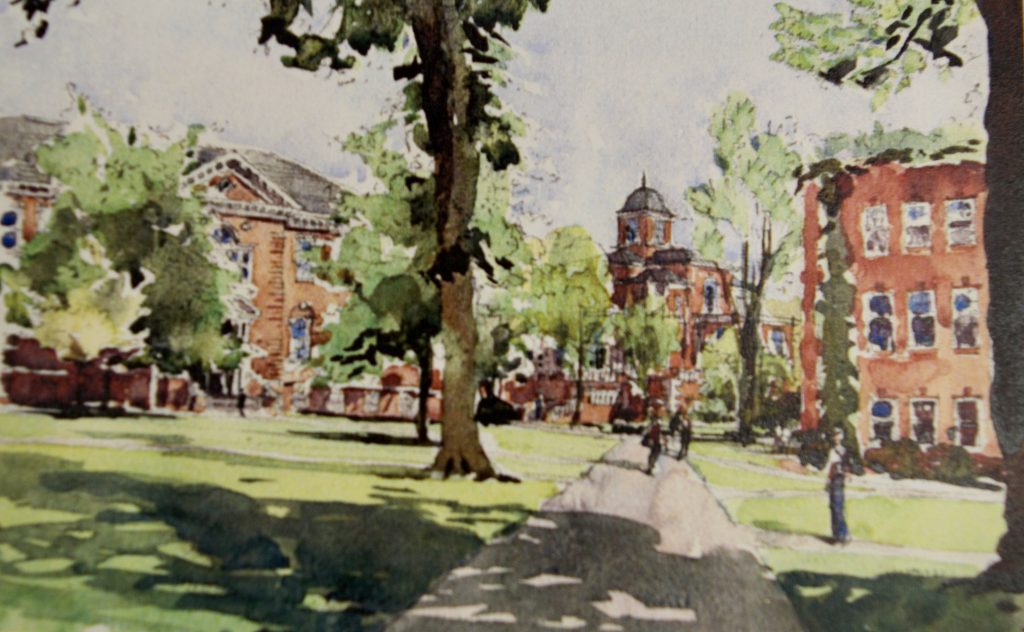
Proposed solutions included treating every building as a historic landmark. This would include Carnegie Science Hall, Seminary House, Rhodes Hall, Emmerson Hall, and University Hall. Moving air conditioners was seen as a reasonable move, as was the removal of the parking lot behind Seminary House. The area was to be planted with various American Liberty Elms and the trees that currently existed were to be preserved.
Dykelands
Highlighted in this section of the CMP were various issues. Flooding was the first major issue, coupled with the lack of multipurpose activity space that could lead to scheduling conflicts. The reduction of athletic and recreational programs and the use of classrooms for athletic meeting spaces were considered detrimental to Acadia Athletics and varsity sports programs, as were indoor leakages, poor signage, and unfriendly indoor track and accessibility concerns. The current swimming pool was identified as outmoded, and the lack of a medical centre, poor bleachers, and worn appearance of everything were highlighted as detrimental to the university at large.
Various solutions were proposed, arguably some of the most radical. They would include the consolidation of all dykeland fields to improve efficiency and decrease flooding, the construction of a boardwalk to connect a dykeland viewing pavilion to the Acadia campus, and various running trails. Tennis courts were to be relocated from beside Crowell Tower to the dykes, with the construction of a press box in case Acadia was looking to add a varsity tennis team to its roster.
An outdoor sports pavilion was to be constructed housing amenities like changing rooms, vending, storage for dykeland playing fields, the boardwalk, and tennis courts. The addition to the War Memorial Gymnasium was to house classrooms for Kinesiology students, with aerobics and activity rooms, locker rooms, and offices on the west side of the War Memorial Gymnasium. Access to the parking lot would be moved west along Main St and a second pedestrian railroad grade crossing would be constructed between the dykeland fields and the main campus. New signage would be added across the area and the existing power plant would be incrementally relocated to a new site at the northern edge of the arena parking lot. This would be adjacent to the railway line and a new natural gas trunk line.
Middle Zone
From the rear of Fountain Commons to the foot of Chase Court, this zone was characterized as dominated by the automobile. There was a lack of mature tree cover, a lack of exterior gathering spaces for students, and no comprehensive building style. The former flat roofs of Dennis House, Eaton House, and current flat roofs of Wheelock Dining Hall and Chase Court posed maintenance problems, energy inefficiency, and related poorly to other buildings.
Solutions proposed included the removal of parking from existing buildings in the Middle Zone. This would alleviate conflicts between pedestrians and automobiles and restore a pedestrian friendly environment to campus through construction of a comprehensive network of foot paths to reinforce positive attributes.

New buildings would be constructed, including a new library attached to Fountain Commons, an academic building east of Tully and Dennis along Highland Ave, a residence hall attached to the south of Eaton, and a residence hall south east of Wheelock Dining Hall perpendicular to Highland Ave. A new residence hall perpendicular to Chipman House between Chipman and Eaton was proposed, manifesting as Roy Jodrey Hall in the early 2000s.
Library
The current library was characterized in the CMP as unattractive and deteriorated. Its shoddy appearance and structural inefficiencies made it unsuitable as a campus library at one of Canada’s premier primarily undergraduate universities. An originally multipurpose building, it has had difficulty adapting as a university library. The CMP identifies how it struggles to meet the needs of students, faculty, and researchers due to a lack of appropriate workspace and facilities. Archive space is inadequate and the horrendous environmental conditions with a “nearly complete lack of ventilation” pose problems for the collections owned by the university.
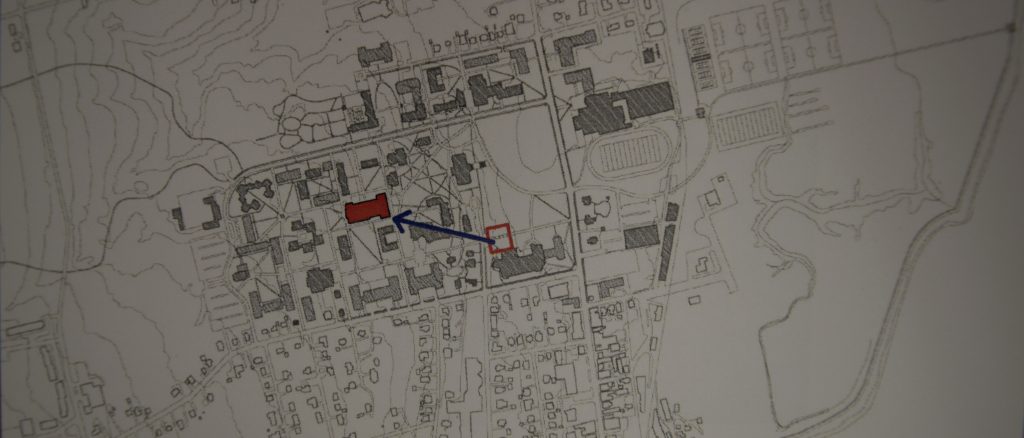
The solution identified in the CMP is to tear down the existing library and build a new one behind Fountain Commons, using the Great Hall as the main reading room. This library would be rectangular, running next to Dennis House. Its central location in campus bridges the gap between disciplines and provides a common working space for students, researchers, and faculty of all kinds.
South Zone
Noted as “bleak”, “windswept” and “underdeveloped”, the CMP gives low marks to the South Zone of campus. The lack of architectural congruency and poor planning has resulted in a barren outdoor environment that does not match the richness of the historic core. Travel between Cutten House and Crowell Tower in the winter is noted as “unpleasant” because of the lack of wind protection, poor landscaping, poor pedestrian circulation, and lack of common space for Crowell Tower and Cutten House. Both residences are also noted for their lack of ability to house upper class students, with their flat roofs contributing to various inefficiencies.

Solutions noted in this part of the CMP correspond with the overall goal of bringing more than 75% of all Acadia students onto campus. The construction of residential colleges with apartment units for students to rent from the university would occur beside Crowell Tower, with lower foreground buildings that mitigate the “intrusive scale” of Crowell Tower. This would add density to create a residential college feel and create quadrangles and outdoor gathering spaces. A bell tower would be constructed between Eaton House, Chase Court, Cutten House, and new residences to act as a focal point, visual terminus and to mark the schedule throughout the day.
Sciences Quadrant
Described as the “front door” of campus, the CMP notes that University Ave is prone to dangerous conflicts. Buildings in the existing sciences area of campus do not open to a coherent pedestrian path system, with unattractive and underutilized outdoor spaces. There is a lack of suitable space for science departments due to increased enrollment and interest in the sciences. Insufficient climate control and poor maintenance have contributed to the disrepair of science spaces and making them a dangerous working environment. Houses lining the western side of Westwood Ave, if not bought by the university, could seriously “compromise the appearance and character of the campus’s western edge”. Privately developed land would undermine Acadia’s goals of increasing the percentage of undergraduates on campus.
Solutions identified include the purchase and demolition of apartments on the corner of Westwood Ave and Main St in the long term. In the short term, they would be used as residences to house visiting scholars and staff. A new science building along Main St. would be built to house classes, labs, and offices for various science departments. It would have entrances facing both Main St. and the newly created science quad.
A second science building behind Huggins Science Hall would be constructed fronting Westwood Ave, in the location of the current University Club. The existing University Club would be relocated to Highland Ave. All properties fronting the west side of Westwood Ave would be purchased and used for visiting scholars and staff, with a new and improved Divinity College on Westwood Ave. across from the KC Irving Centre. This would open up to the university’s Greenbelt.
Patterson Hall and the Biology building would be connected, forming a new Centre for Life Sciences, with a new system of quads and foot paths created for outdoor spaces. University Ave would be purchased from the Town of Wolfville to lessen the impact of vehicles. Traffic calming devices like raised intersections would be installed, and on-street parking would be relocated to the rear of campus. The new University Ave would be 24 feet curb-to-curb. Lighting would be at entrances and key architectural features of buildings only.
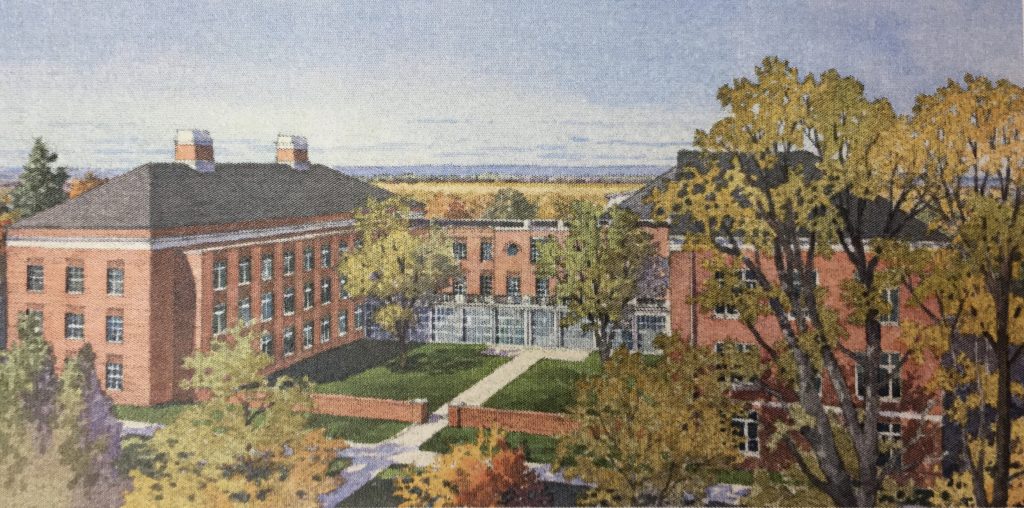
Acadia University has already acted on these recommendations, with the wholesale exterior redevelopment of the Huggins Science Complex, interior of Elliot Hall, and construction of the Huestis Innovation Pavillion.
Humanities Quadrant
The current eastern side of campus does a poor job as the eastern “front door”, with abundant parking lots and roads dominating sites that impede pedestrian movement. There is little to unite the small houses south of the BAC and little in terms of a ceremonial campus entrance, with no defined eastern gateway to the Acadia campus. The large scale of university buildings contrast poorly to the smaller scale wood frame houses east of Highland Ave, making Acadia appear imposing. The Student Union Building is noted in the CMP as insufficient for student use due to increased programming and serious maintenance and refurbishment needs that are not consistent with the quality of Acadia.
Solutions identified include the wholesale redevelopment of the Student Union Building and the construction of a new one along Highland Ave. This campus centre would be a more academic space, set back from Highland Ave to match the BAC. It would occupy a prominent position and define the eastern edge of campus.
Alumni gates would be moved to the intersection of Highland and Acadia St. with a more refined design to create a ceremonial entrance. Vehicular access and parking would be deceased as part of an overall strategy to remove parking to the campus perimeter, and service roads would be minimized to de-emphasize their impact on a pedestrian dominated campus.
The visual impact of the BAC would be lessened by adding a three-story addition west of the intersection on Main St. and Highland Ave, which would include an art gallery, classrooms, and a museum dedicated to the university, town, and regional history. The existing Divinity College would be torn down and replaced with a new academic building, in addition to a new garden adjacent to the Campus Centre in the former backyard of Hayward House. Raymond Hall would also be relocated east of Wheelock Dining Hall.
Greenbelt
The CMP identifies considerable potential with the Greenbelt. It would reinforce the image of Acadia as a campus partially embedded in the native forest while opening towards the riparian tidal meadows and Minas Basin beyond. It is currently not one piece of land because University Ave breaks it apart, which is currently occupied by unmaintained meadows. Walking trails are not well linked as several properties are not owned by the university.
Solutions identified include the wholesale purchase of University Ave from the Town of Wolfville and demolition of the part between the end of campus and Skyway Drive. This would eliminate the poorly used athletic fields south of Crowell Tower and replace them with more suitable ones by the dykes, which would allow for the enlargement of the Greenbelt.
Catherine Court apartment buildings would be purchased south of campus and west of Highland Ave to expand the Greenbelt, with improved construction and maintenance of walking rails. A natural sciences interpretive guide for the greenbelt would be developed and published to promote research and comprehensive standards for replanting and maintenance would be developed. Additionally, all private properties along Westwood Ave between Westwood and the university would be purchased, as would the town-owned portions of Westwood Ave south of the KCIC and between Westwood and University Ave. These would close the roads and add to the overall Greenbelt.
Progress
Acadia has made progress on the CMP. In an interview with The Athenaeum, Director of Facilities Marcel Falkenham noted that the CMP “is more of a guide than gospel. This is a plan of where we want to be in the long term, so it’s pretty malleable.”
Some of the steps taken to achieve the goals laid out in the CMP have been achieved. Fountain Commons, formerly McConnell Dining Hall, was refitted in a previous capital campaign. Uniform signage courtesy of the 2017 Grad Class now graces campus. Horton Ave, the road from Wheelock Dining Hall to the BAC, added planters down the centre in 2013. The federal government is investing in the Athletics Complex. Lighting is now more uniform across campus. The redevelopment of Huggins and Elliot fits with the aesthetic qualities of Acadia’s architecture. The construction of the Huestis Innovation Pavilion fits with the CMP’s goal of bridging the divide between the university and local businesses. Though these changes may take time and money, they are not impossible.
A copy of the Campus Master Plan is available at the Acadia University archives.


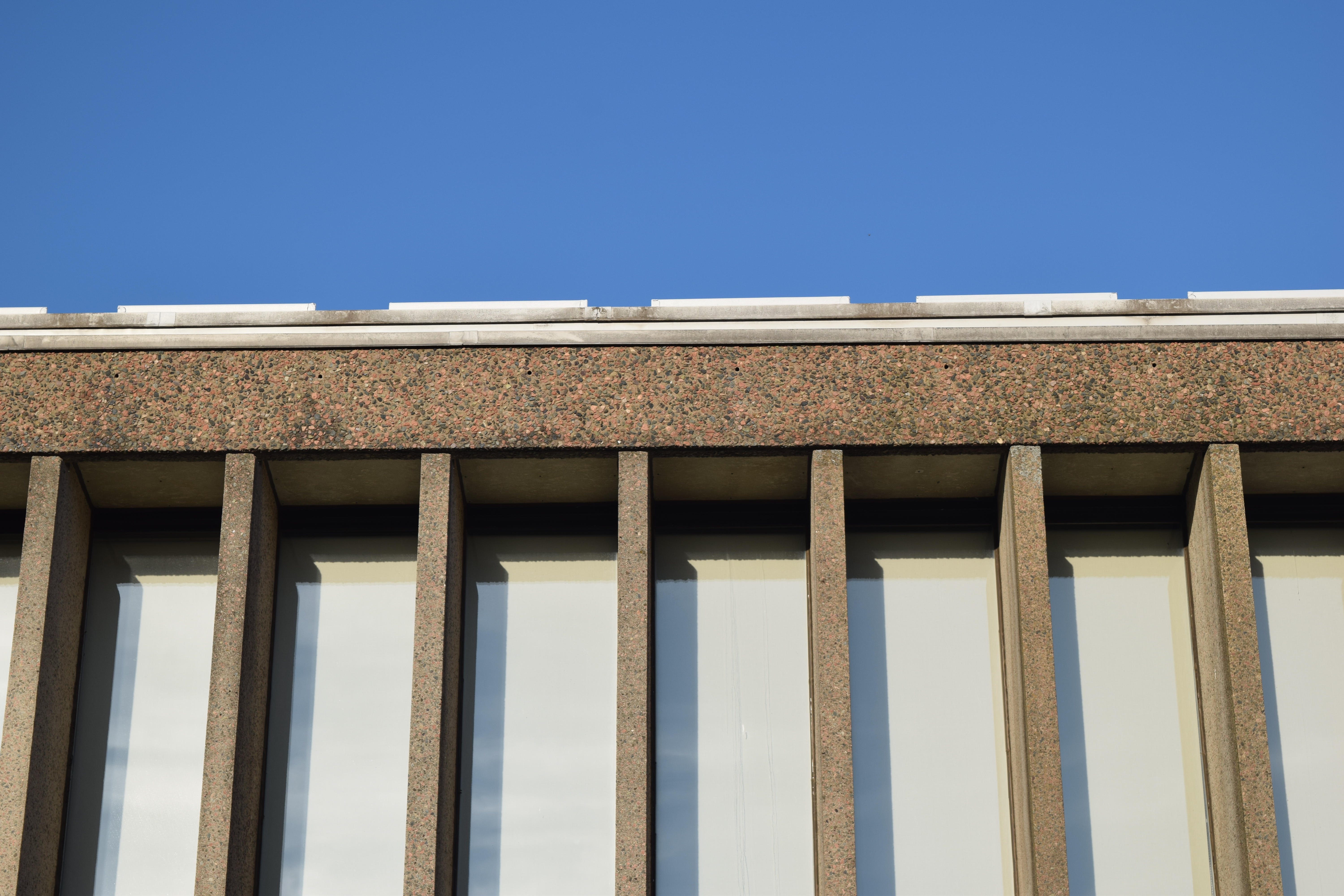
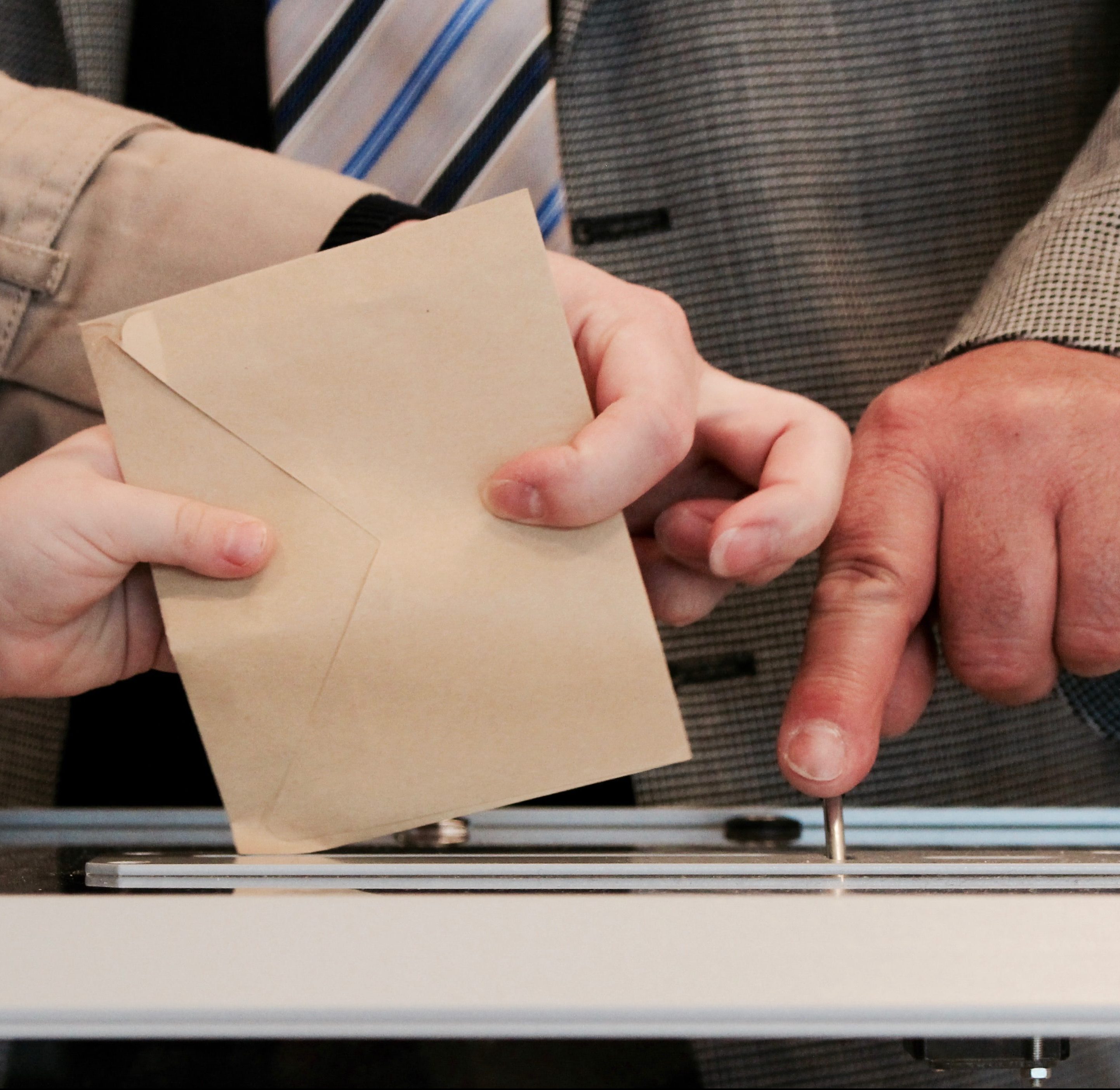

Good luck trying to get 75% of students to live on-campus. Some of us like the independence, freedom and lower costs of living off campus.
I moved off campus and I sure don’t miss having to ask permission to have my girlfriend over, having nosy RA’s prying into my life, knowing that my room can be searched at any time for any reason, paying way above market rate for rent and being forced to pay into an overpriced and disgusting meal plan.
And I can even play beer pong without having to hide it.
Hear hear, man. I’m an older student with a husband and animals, too. While there was mention of apartments, I doubt they’d let me dog in so still going to be living off campus anyway because y’know, some people enjoy the presence of animals in their life.
Absolutely fantastic article and I’m glad you’ve brought light to this plan 🙂 While the comment above about beer pong and partying is definitely true, I think this would move Acadia into a more favourable, academic light and bring Acadia back to its roots; an esteemed centre of higher education.
These drawings make me think of Harvard and I think Acadia is close, but could get even closer to the same look, perhaps even approach it in ways beyond the physical.